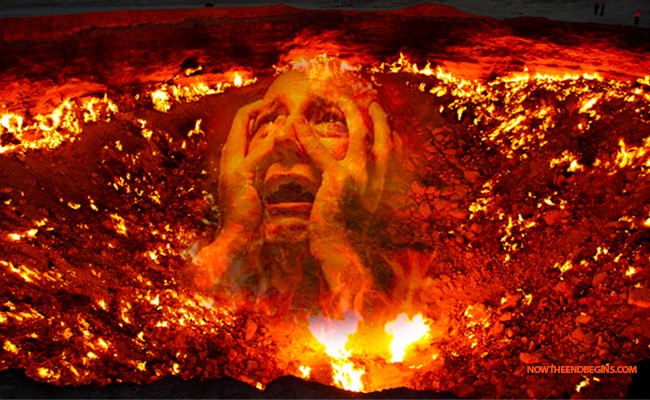TO HELL & BACK – Continuing the Conversions debate

Chhotebhai
25 August 2017
 A forward from a well-intentioned Catholic claimed that all those not baptised in the Catholic Church were going to Hell. His contention was based on some papal document of 1928 and subsequent Marian apparitions. I received this just a few days before my darling grand-daughter’s baptism. I could not imagine that angelic beauty burning in Hell, if for any reason she had remained unbaptised!
A forward from a well-intentioned Catholic claimed that all those not baptised in the Catholic Church were going to Hell. His contention was based on some papal document of 1928 and subsequent Marian apparitions. I received this just a few days before my darling grand-daughter’s baptism. I could not imagine that angelic beauty burning in Hell, if for any reason she had remained unbaptised!
A week later I got a Sunday morning knock at my gate. Three young Bible-thumpers were all set to baptise and save me! A month earlier a similar group had come. They were in their twenties. I wondered what they knew of life, sacred scripture, salvation, or the nature of God? Would they be knocking at the doors of the “gentiles” telling them that they had a one-way ticket to hell if they were not baptised? Were such zealous youngsters brainwashed into believing that they were on a divine mission? Could their simplistic arguments actually result in animosity rather than goodwill? And anti-conversion laws a la Jharkhand or adverse feelings al la Gandhi.
As with all such propagandists, the Bible was thrown at my face. Jesus’ last command was to baptise all (cf Mat 28). I retorted that the Last Judgement would not be based on baptism or evangelisation, but on reaching out to those in need (cf Mat 25). Such countervailing arguments cut no ice with the zealots.
Lest this sound like a tirade against Evangelical Christians let me recount a hoary old tale from a former parish priest. It relates to the period when zealous missionaries like St Francis Xavier set sail across the seven seas to save “pagan souls” in places like India. While crossing the Arabian Sea a devout Catholic priest saw another ship, with 500 aboard, sinking. Here was the God-given opportunity that he had been waiting for. There was danger of death (in which circumstance the Catholic Church advocated baptism), there was an abundance of water, and of course the priest! So he sanctimoniously stretched out his hand and baptised them en masse. That night after saying his rosary he thanked God and made an entry in his diary, “Saved 500 pagan souls from going to Hell”.
Such anecdotes could sound funny, were they not true. In the past, overzealous missionaries “baptised the pagans”, sometimes even by hook or by crook, because they felt that the ends justified the means. In this regard much has changed in the perception of the Catholic Church; though seldom, if ever, mentioned in sonorous Sunday sermons. Before we come to that let us delve back in the past to go to Hell and back.
 The “Dictionary of the Bible” (DOB) by Rev J McKenzie SJ is a standard text book in Catholic seminaries. I quote extensively from the same. In the Bible the word for Hell is GEHE NNA. In Greek it is GEENA; in Jesus’ native Aramaic it was GE-HINNAM, and in Hebrew GE-HINNOM. It literally means the Valley of the son of Hinnom. Interestingly even Muslims use the word GEHENNAM for Hell. Etymologically the word refers to the original Jebusite owner of that valley. It was a place used for cultic human sacrifices and dead bodies. The emphasis was on a PLACE, a geographical location. It employed the imagery of contemporary Judaism. In Jewish rabbinical literature there is a possibility of release from the place after a period of punishment. The DOB asserts that this is basically imagery and not a literal theological affirmation. The details of the afterlife are not disclosed, except in imagery (DOB Pgs 299-300).
The “Dictionary of the Bible” (DOB) by Rev J McKenzie SJ is a standard text book in Catholic seminaries. I quote extensively from the same. In the Bible the word for Hell is GEHE NNA. In Greek it is GEENA; in Jesus’ native Aramaic it was GE-HINNAM, and in Hebrew GE-HINNOM. It literally means the Valley of the son of Hinnom. Interestingly even Muslims use the word GEHENNAM for Hell. Etymologically the word refers to the original Jebusite owner of that valley. It was a place used for cultic human sacrifices and dead bodies. The emphasis was on a PLACE, a geographical location. It employed the imagery of contemporary Judaism. In Jewish rabbinical literature there is a possibility of release from the place after a period of punishment. The DOB asserts that this is basically imagery and not a literal theological affirmation. The details of the afterlife are not disclosed, except in imagery (DOB Pgs 299-300).
In the New Testament, when Jesus refers to Hell it is described more as a STATE OF BEING, rather than a PLACE. There is darkness, gnashing of teeth etc. Interestingly, in various letters addressed to the Gentile converts, this Judaic imagery is not used, as it was foreign to their culture and ethos. An erudite preacher and writer like St Paul candidly admits of the future that “Now we see reflections in a mirror, mere riddles, but then we shall be seeing face to face. Now I can know only imperfectly” (1 Cor 13:12).
While Paul cautions against drawing hasty conclusions, the contemporary teachings of the Catholic Church also express a nuanced approach. The Second Vatican Council (1962-65) was a watershed in the Church’s self-understanding, and its consequent attitude to “others”.
I consider the “Dogmatic Constitution of the Church” (Lumen Gentium) to be the pivotal document of Vatican II. Referring to non-Catholics it clearly annunciates, "The Church recognizes that in many ways she is linked to those who, being baptized, are honoured with the name of Christian, though they do not profess the faith in its entirety or do not preserve unity of communion with the successor of Peter … They are consecrated by baptism, through which they are united with Christ …Likewise we can say that in some real way they are joined with us in the Holy Spirit" (LG15).
In like manner it says of non-Christians, “Those also can attain salvation who through no fault of their own do not know the gospel of Christ or his Church, yet sincerely seek God, and moved by grace, strive by their deeds to do his will as it is known to them through the dictates of conscience. Nor does divine providence deny the help necessary for salvation to those who without blame on their part, have not yet arrived at an explicit knowledge of God, but who strive to live a good life, thanks to his grace” (LG 16). This means that even professed atheists can be saved, and echoes the mind of Jesus that “he causes his sun to rise on the bad as well as the good, and sends down rain to fall on the upright and wicked alike” (Mat 5:45).
This leaves absolutely no room for doubt, that God’s grace and Jesus’ salvific work is for all. Then why convert?
These sentiments are echoed in the official “Catechism of the Catholic Church” promulgated by Pope John Paul II on 11/10/1992. It says, “Every man who is ignorant of the Gospel of Christ and of his church, but seeks the truth and does the will of God in accordance with his understanding of it, can be saved. It may be supposed that such persons would have desired baptism explicitly, if they had known its necessity” (CCC 1260). As for Hell it states that “The teaching of the Church affirms the existence of Hell and its eternity” (CCC 1035). But who goes there? In the past moralists laid emphasis on cognizable “mortal sins” like murder and adultery (5th & 6th Commandments). However, the CCC seems to focus more on the 1st Commandment that is not so tangible. It says, “The state of definitive self-exclusion from communion with God and the blessed is called Hell” (CCC 1033). Notice that it is referred to as a state of being, and not a place. Devoid of theological jargon, it is not easy to go to Hell!
Rather than being judgmental the CCC is more considerate of human frailty, when it says, “The affirmations of Sacred Scripture and the teachings of the Church on the subject of Hell are a call to responsibility incumbent upon man to make use of his freedom in view of his eternal destiny” (CCC 1036). Further, “God pre-destines no one to go to Hell; for this a wilful turning away from God (a mortal sin) is necessary, and persistence in it till the end … the Church implores the mercy of God who does not want any to perish, but all to come to repentance (cf 2 Pet 3:9)” (CCC 1037).
From this I would deduce that isolated sins against the 5th/6th Commandments (invariably singled out for sending people to Hell) certainly do not merit eternal damnation. A serial killer, a rapist or other criminal may be doing cruel things, but such acts may not be deliberate or definitive acts of denial of God. They are acts of human frailty rather than of spiritual rejection. They deserve exemplary punishment (purgation) but not eternal damnation.
This is why Pope Francis constantly talks of God’s mercy. I believe that God’s love is infinitely greater than the worst criminal acts that a human may undertake, including the likes of Judas or Hitler.
Why then so much talk of Hell and eternal damnation? Before Vatican II almost everything, from missing Mass on Sundays, was a mortal sin. The fear of Hell, fire and brimstone, stampeded the dumb sheep and cattle class into the churches. Fear was the key, not the love of God.
I believe that the two strongest human emotions are love and fear; the carrot and the stick. Unfortunately, most human behaviour is based on fear – of society, of God, of the unknown, of what people will say, of what will happen tomorrow; rather than motivated by love of God, humanity or nation. At the agony in the garden Jesus experienced the fear of the excruciating pain of the crucifixion. But then a superior emotion, love for God’s people, took hold of him when he exclaimed, “Nevertheless, let your will be done, not mine” (Lk 22:42).
John has these wonderful words for us, “In love there is no room for fear, but perfect love drives out fear, because fear implies punishment, and whoever is afraid has not come to perfection in love” (1Jn 4:18). So let us focus on love, and leave judgment and Hell to the merciful Father who does not desire that even a single one should perish. Paul’s earlier uncertainty about the future ends with these words of certitude, “Meanwhile these three remain: faith, hope and love; and the greatest of these is love” (1 Cor 13:13).
As for conversions, if they are based on love and truth, they are to be welcomed. If, however, they are motivated by threats of divine displeasure, fear, force, allurement, or misconceptions, then they should be firmly discouraged. For we don’t know who, if any, are going to Hell; and nobody has come back to tell us about it.
* The writer, past President of All India Catholic Union, has been deeply involved in youth and adult catechesis.
















